Barry Lenoble
Feb 8, 2000
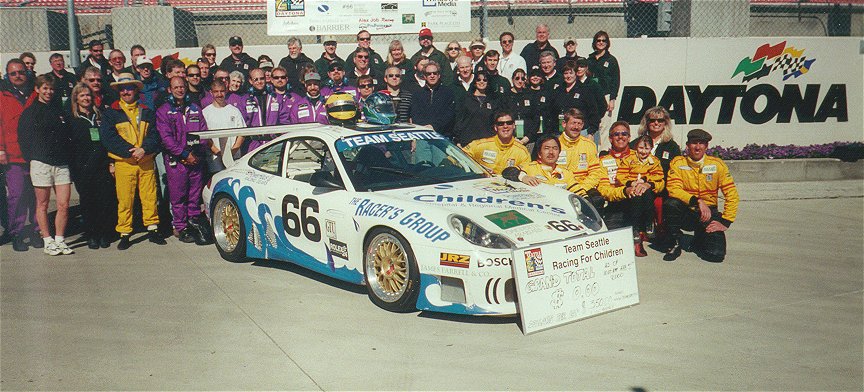

Back in December, a friend of mine asked me if I would be interested in working the 24 hour sports car race in February. It took me about 5 minutes to say yes. I found out that we (4 of us flying down from NY) would be working on Kevin Bucklerís The Racerís Group team. I had no idea what my role would be, but I didnít care. Regardless of what happened, it would be an experience.
Fast forward to February 2. We (Chris Manfredi Ė owner of Lynmor Automotive Service Ė a Porsche specialty shop in Huntington, NY, Rich Ė Chrisís chief mechanic at Lynmor, Henry Hoeh Ė past president of Metro NY PCA, Driver Ed instructor, and top notch amateur mechanic, and me Ė club racer and wrencher on my own cars) fly down to Orlando on a 7:00 AM flight, rent a car, and drive to the track.
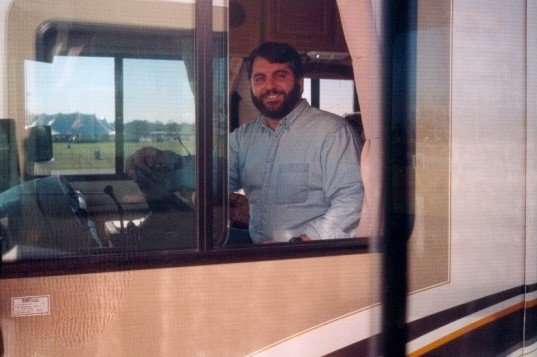 Here's Henry playing truck driver
Here's Henry playing truck driver
At Kevinís request we stop off at El Monte RV to pick up two gigantic Bounder RVís for the driversí to rest in during the race, then we head over to the speedway. By the time we picked up our credentials, got the RVís inside and parked and headed towards the garage, it was 4:00 PM. We find the garages, meet Kevin Buckler, see the three cars and try to be helpful. The garage closes at 5:00 PM sharp, so we head to our hotel, unpack, eat dinner, and found some Ďentertainmentí.
Head to the track Thursday morning, arrive
at 7:30 AM when the garage opens. Henry gets assigned to the #68 car, the
Purple 911. Chris gets assigned to the #67 GT3R, Richie and I are on the
#66 GT3R. So far, there are 7 people on the team, Sid Collins - the crew
chief, Richie Binzer Ė chief mechanic, Forrie, the assistant mechanic,
David Pyles (Radar) - radios, fuel, lots of other stuff, Richie B from
Lynmor Ė mechanic, David (Micro) Ė Tires, and myself (go-fer). Once I saw
the car I realized that this was the Team Seattle car Ė the one that donates
money to the Childrenís Hospital of Seattle. Very nice.
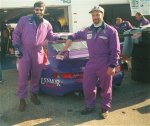 Here's a shot of Henry and me in front of the #68 911.
Here's a shot of Henry and me in front of the #68 911.
The first serious task we did was corner balance and align the car. My job was very difficult Ė I had to sit in the car to simulate the weight of a driver. I sat in the driverís seat and stepped on brake pedal when told, and took my foot off the brake pedal when told. It was pretty tough. The other guys were busy rolling the car onto the scales (I put brakes on), checking weight, height, and chamber, and adjusting settings, rolling the car off the scales (I take my foot off the brakes) to settle the suspension (brakes back on), then rolling the car back on the scales to check the settings. After an hour of this they pronounced the car Ďreadyí. It didnít look ready to me Ė lots of things still werenít done Ė like the in car fire bottle was laying on the floor, the radio didnít work, the shift light was not connected, etc. Eventually we got most of the stuff done Ė I actually helped connect the in-car fire system.
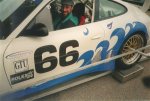 Here I am working hard. Later I got to steer the car. People even took
my picture!
Here I am working hard. Later I got to steer the car. People even took
my picture!
The drivers stopped by to look at the car, they were Don Kitch, Steve Miller, Dan Daylord, and Kiichi Takahashi from Japan. The drivers didnít seem too interested in the car Ė they were more interested in making sure the proper stickers were on the car. If I were a driver, Iíd want to know how the car was set up, not whoís sticker went where, but what do I know?
So the car is all aligned and ready to take to the track. The team pushes the car back off the alignment platform (brake off), then Sid (crew chief) asks me to start the car up. Hey, I get to start the car? Very cool! But there is no key, how do you start it? Sid tells me to turn the main ignition switch to on, press the main power button, wait for the dash to come on, then push the Ďstartí button. I do that, the engine turns over, and a nice throaty roar starts. The car stalls, so I restart it, and give it a little throttle. I watch the gauge display carefully, and Sid says to tell him if the water temp gets too high (whatís too high?). After a few minutes, the oil and water temp are good, the oil pressure is good, so I turn the car off. The crew pushes the car to the garage, while I get to steer it. Hey, Iím sitting in a factory built race car! Itís not driving, but itís more than I expected.
In the garage we add some fuel, check the car over quickly, then the chief mechanic, Richie, drives the car to the pits. I walk to the pits (I would do a LOT of walking before the weekend was over) with the radio guy, find the pit stall, and see the car on pit lane. Don Kitch gets in and takes the car out for the first practice session. He does some easy laps, I donít think any one lap was faster than 2:05 before the session ends. During the practice session Kitch brings the car onto pit road for tire temps and pressures. He seems happy with the car. We add some water and oil to the car, and itís fine.
Back to the garage, we prepare the car for the first qualifying session. For me, that meant cleaning the car. I find some paper towels, some Windex, and run back to the trailer for bug and tar remover. The real mechanics are looking the car over Ė checking brakes, suspension, engine, coolant (new for the teams), while I remove bits of rubber, dead bugs, and make the car all nice and pretty. Before qualifying the crew chief and head mechanic discuss the tire readings and decide to make some alignment changes. Back to the trailer, put the scales back in the rack, get the car back on the alignment rack. Don Gaylord is there, so he gets in the car and we take some readings. I record the chamber and ride height settings. To me, it seems like there is too much negative chamber on each wheel. The tire temps show that the inside edge is much hotter than the outside edge, even on the right side tires. The chief mechanic sees the same thing, so we take ½ a degree out of each wheel. Ride heights are fine, toe settings are OK too.
Qualifying time, the car heads to the garage, crew to the pits. Weíve got soft Pirelli qualifying tires ready. On pit lane the car goes up on the air jacks (boy those things are cool) and the gumball tires go on. Kitch gets in and heads out. We watch the car go by. Start timing laps. Lap times start in the 2:10 range but quickly drop. Kitch does a best lap of 2:01.4 or so, and everyone is happy. That time should be good enough to get us into the race. There are too many cars entered, and some of the them are going to be heading home early. The fastest GTU 911ís are in the 1:53 range, weíre not even close to that. To me (who doesnít know anything about real racing) the car seems set up OK, the tires are good, maybe the drivers arenít?
Qualifying is over, back to the garage. I clean the car. Prepare it for night practice. Each driver is going to get some seat time. Back on the alignment rack. Just check settings. The left rear tire changer, PCA Club Racer Mark Hufpner arrives. We say hello then check the car over. The radio still isnít working right, the wrong mirror is still in the car, and now the "water" light on the dash is lit when the car runs (but temps are fine) but the car heads to the pit for night practice. I donít have a radio, so I have no idea what is going on, but the car seems to run fine. Each driver gets in and does a stint. In the pits we donít have too much to do. Session ends, all cars back to the garage. Kevin asks me to re-arrange the pit layout Ė we have two pits spaces for 3 cars, but the tents that are set up donít work well for sharing space. So three of us spend about an hour rearranging the tents to make one large pit space. Much better. Hey, Iím actually contributing to the team!
With the pit done I walk back to the garage. The Oreca Vipers are located right next to us in the garage. I check the cars out Ė very cool stuff, especially the rear diffuser. The #66 car is fine. We clean it, do some work on the interior. Not much time before the garage closes at 9:00PM and we head home. Thursday is complete. We have to be back at the track at 7:30 when the garage opens, so we head back to the hotel and go right to sleep.
Friday comes way too early. Iím tired, but feeling good. Get to the track, park, find the crew working on the car. Kevin (owner of The Racerís Group) and Sid the crew chief are not happy with our qualifying time. There is a second qualifying session, and if other cars improve enough, we might get bumped. So we work to prepare the car for another qualifying session. We make some suspension changes, and head to the pits. Kevin will drive this time. He gets in the car (same tires as yesterday) and heads out. First lap is a 2:10. Second is a 2:02 or so. Third is under 2:01 (best so bar) and his 4th and 5th laps are 1:59.XX. He then complains that something is wrong with the car, and comes in. Regardless, his times will easily put the car in the race. It turns out that the shift lever came off in his hand, and something was wrong with the suspension.
Back to the garage and trailer to check the car and prepare for the final practice session. That means changing the brakes (both pads and rotors) and the rear axles so we can have back-ups ready if something happens during the race. I help assemble the rotors. GT3R rotors come in two pieces, the rotor, and the hat, the front and rear are different. I help Dave do one, then do the other. OK, thatís done. We take the car back to the trailer, and check the alignment again (boy we do that a lot). There we install the new axles (which is a real pain). I assist by getting tools for the real mechanics. Itís time to head out for practice, and the car is still not done. The drivers are waiting, and we furiously work to get the car done. I try to help, and to stay out of the way when I canít. Kevin comes over. We talk for a while. Kevin seems very relaxed. I donít know how he can be. If I had to manage three cars, 11 drivers, three teams and countless people I would probably have a heart attack. Instead Kevin is calm and cool. We talk about club racing, drivers, teams, and things like that. I feel really happy to be working on this team.
Finally the car is ready and heads to the pit. Normally we would put old tires on for the ride from the paddock to the pit, then change to the proper tires on pit road. There is no time for that (weíre late) so the car heads to the pits on race tires, the driver will do some laps, then come in, check tire temps and pressures, change tires, then head back out. My job is to take the tire pressures after the stop. Don Kitch is driving, car is good. He comes in after 10 laps, tires off, fresh tires on, car back out. I take pressures on the tires that just came off, LF is 30, RF is 29, LR is 30, RR is 10! What, 10 psi in the RR (that tire has the highest load at Daytona)? I check it three times, 10 psi and dropping. Must have picked up some debris. I give the numbers to Ray, who is doing timing and scoring, and tell him about the RR. The car is on the track, and doing well. Then Sid grabs me and asks me about the RR tire. I tell him I checked it three times, it has only 10 psi, and is dropping. Sid is pissed. He tells me that you canít send a car out there with 10 psi, itís dangerous. I nod OK (itís very difficult to talk in the pits, very loud). Sid tells me (and everyone else) that this is a TEAM, and that ANYONE can stop the car from going if they feel it is dangerous. I tell him OK. At this point Iím confused. Yes the RR was going flat (I checked it again, and it had no air). However, it was no longer on the car, so what was the problem? What was I missing? I decide that after the session ends I will talk to Sid and find out what I did wrong. Sid wants to stop the car and check all tires. Car comes in, I check tires, all are fine, RR is 32. Sid asks how could it be 32 when it was 10 before? Chief mechanic tells him that is a different tire, the flat tire is in the pit. Now Sid understands. Later, he comes over to me and apologizes. He thought the tire was still on the car. Now I understand why he was so upset. Sid goes up a few points in my estimation. I was going to talk to him anyway, he beat me to it, and apologized.
Session ends, over to the trailer. Weíre going to work on pit stops. Sid tells people their assignments: Richie Binzer, the chief mechanic, is the right front wheel changer. Richie from Lynmor is the right rear wheel man. Mark is the left rear wheel man, Forrie is left front wheel man. David Pyles, AKA Radar, is the fueler. Iím the fire-man. I go over the wall during pit stops with a fire extinguisher, and protect the fueler, then the driver during pit stops. Ray will be doing timing and scoring, he times the pit stops. Sid explains that this is not NASCAR, no one is going to win the race with pit stops, but you can lose the race if you make a mistake. He wants us to work slowly and surely. The fueling operation takes the longest time, so there is no need to rush. The wheel men are told to work methodically. Donít drop the wheel nut, make sure to get the safety clip back on. The fueler has to make sure to get the nozzles completely into the opening. I just have to stand there and be alert. I can do that! We practice for 15 minutes or so, until everyone is comfortable.
Back to the garage. Prep car for the race. Brakes need to be bled, clutch needs to be bled, car needs to be cleaned, fueled, completely checked, etc. It seems like there are a million things to do. I clean the car, help Richie torque the rear axles. Forrie takes the nose off the car. Mark cleans all the radiators. I try to help as much as I can with anything that needs to be done. The Motorola cup race is going on, but I donít see any of it, as Iím too busy. Sid comes over to me and explains exactly what my role is. I must protect the fueler, once heís done the driver is top priority. I have to help get him out if thereís a fire. Sid tells me I have to wear a full fire suit, nomex head sock, goggles and gloves. Good thing I brought my own balaclava Ė I find some in the trailer, but theyíre pretty gross, I would not want to wear one of them for 24 hours!
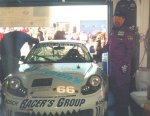 here is Richie from Lynmor posed by the #66 car.
here is Richie from Lynmor posed by the #66 car.
The garage closes at 6:00PM, and they kick us out.
Head to dinner at a local place. Wait at the bar for a table, have a beer. Kevin walks in and sits down with us (Me, Richie, and Chris). We chat for a while, then Kevin heads over to visit with the #68 team, they are having a team dinner. My group gets a table. Weíre about to order when Kevin walks over and sits down. He says that he would rather hang out with us instead of the other team. Monte Smith (PCA Club Racing steward) sits down at a table behind us. We say hello, he talks with Kevin. I tell Kevin my Sebring story. I was at Sebring to watch the club race in í96. In the group A race, Kevin was leading a tight battle for almost the entire race. Then, with 1 lap to go, he suddenly slowed, then went again, and eventually finished second. I had been corresponding with Monte Smith via email, and I got the story behind it. Kevin laughs about it, and I tell him that seeing that race is what made me decide to go club racing. Dinner ends, we head home. Tomorrow is going to be a LONG day, we have to be at the track at 7:00, race starts at 1:00PM, and doesnít end until Sunday at 1:00PM. Oh boy.
Saturday, arrive at the track early. Itís getting crowded. Park near the RVís, and head to the garage. Work on the car and the pits. Thereís going to be a team photo at 11:00, so I have to remember that. Put on my Racerís Group suit then help empty the garage and prepare the pits. We push the "war wagon" full of tools and gear into the pit space. I help set up the pits. Sid wants the pits neat and clean. There are shelves, so I stack bags, quarts of oil, bottles of water, and all sorts of stuff back there. I organize the tool chest, make sure I know where things are, and label each drawer. Work for a while, various friends stop by, we chat a little. Time for the photo. Help push the Team Seattle, #66 911 GT3R to the wall for photos. Sid is helping. Suddenly Sid starts limping. Something with his knee. Uh oh, trouble already, and we havenít even made it to the grid! I found out later that someone was walking through the paddock with a piece of angle iron, didnít look where he was going, and whacked Sid in the knee with it! Heís hurt pretty bad, and can barely walk. What are we going to do? Well, Sid is pretty tough. Some ice, some Advil, a crutch, some duct tape (it works on more than cars) and Sid says heíll make it.
All three cars are there, clean, ready to run. The drivers are all there. The team Seattle car will raise about $350 per lap, everyone is very happy about that. Get lots of pictures. Photo session ends, I head to the pit. The cars are on the grid, I walk about the grid and take it all in. Very cool. Back to the pit. Hear the national anthem, then "Drivers, start your engines!" All gear on, Sid wants us ready in case something happens. The cars head onto the track, The team cheers when the 67, 66, and 68 cars go by. Watch the pace car go by, then the green flag drops (weíre directly across from the Start / Finish line) and the race starts!
I watch from the pit wall as the race starts. From there, you canít really see anything. There is a TV in the pits, so I try and watch, but itís too crowded. Basically, I just stood around. I was wearing headphones connected to my scanner (there werenít enough radios for everyone to have one, this way I could head the crew chief and driver), when at the 15 minute mark or so I hear Don Kitch say that he has run over some debris and is coming in! Great, I was pretty nervous anyway, I hoped heíd stay out there for some time so I could relax, but no way. I push my goggles down, find my extinguisher and make my way to the wall. I stand as far left as I can, just to the left of the right front wheel man, so I donít get in his way. Kitch pulls in, Sid stops him on the line, we go over the wall. I find my position and watch Radar fuel the car. Since the car hasnít been running very long it doesnít take much fuel. Move to the pit wall and watch Kitch. Tires on, car down, car away, pit stop over! Back over the wall. OK, first stop down.
Weíre now back to 70th position or so, but itís a long, long race.
Wait around for an hour. The #67 is going to come in. Grab my fire bottle and move to the wall. The car is in, their team goes over the wall. We help pass tires, retrieve tires, and pull air guns back. I look at the car, and I see water pouring from the rear. Try to get the crew chiefís attention, but he doesnít see me. By now, everyone on my team sees the water, and we try to get the chiefís attention. Finally he sees us, and the car is shut down. Reps from Porsche Motorsports, including Alwin Springer, come running over with a big selection of hoses. The team goes to work. They replace a hose and fire the car up. No good, water pouring out. They push the car off the pit, and back to the garage. Bummer for them, I think their day is over. Later the #68 car comes in. Theyíve been out for about 1:45 minutes. Thatís a long, long time. Good stop and the car is away.
The #66 car is running smooth steady laps. I hear Sid talking to the drivers, keeping them calm, reading the water and oil temps, telling them lap times. So far so good. Weíre moving up in the standings. Sid is hobbling around, but he says heíll make it.
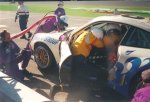 The team working during a stop. I'm at the top, with the mask on.
The team working during a stop. I'm at the top, with the mask on.
The #67 car returns. The water pump was bad, replaced in about 45 minutes. Back in the race.
Itís now about 2:30 pm. Sid tells us to get ready for a pit stop. Balaclava on, suit zipped up, gloves on, goggles on, fire bottle ready. Over to the pit wall. Listen to Sid talk to Don. Sid tells Don to wait until the engine bobbles, then switch to reserve tank, then come in. Sid looks at each crewman and makes sure they are ready. We are. Wait for another few minutes. Don calls in that heís on reserve. Sid tells him to pit this lap. Sid is hobbling on pit road, car comes in and stops on Sidís mark. We go over the wall. The pit stop is fine, driver changed to Steve Miller, car away. Back over the wall. The Team Seattle car is moving up. The Sports Racers are dropping like flies. Weíre running steady laps, and gaining.
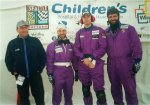 Metro
NY PCA Members Bob Slawson, Barry Lenoble, Chris Manfredi and Henry Hoeh
Metro
NY PCA Members Bob Slawson, Barry Lenoble, Chris Manfredi and Henry Hoeh
One and a half hours later itís time for another driver change. Miller out, Kiichi in. Stop is good. Once the car leaves pit lane, we have to prepare for the next stop. The wheel men get tires, make sure the air lines to the guns are straight. I help the fueler and dead-man fill the fuel rig. You connect a hand cranked rotary pump to a 55 gallon drum of fuel, put the other end into the fuel rig, and start cranking. One person monitors the fuel rig, one person mans a fire bottle, the other cranks the pump. Itís gets old after the first fill operation, but it must be done every time. OK, so we are filling the fuel rig when we empty the drum. Time for a new drum. We keep two in the pit space, one to be connected to the fuel rig, and a full one ready to do. I help the dead man, Phillip, move the empty drum and get the new drum (the full drums are HEAVY). We move the drum in place, I connect the rotary pump to the drum, then start cranking. Fuel starts pouring out, and gushing everywhere. I stop cranking (duh) and see that the top of the fill line was disconnected from the fuel rig, so we could replace the drum. About a gallon of 110 octane fuel has spilled in the pits Ė not good. The #67 team quickly grabs rags and helps up soak up the spill. Later their team manager came over to me and to told me to be careful Ė thanks, I needed to hear that. I think back to what Sid said, slow down and take your time. Got it, no more mistakes.
So this went on into the night. The #67 car broke another water pump about 10 hours after the first. They were back on about 30 minutes. The #66 and #68 kept on running strong. Both cars were moving up in the standings, up into the 30ís. Very good. Snacks were served, then dinner, then more snacks. Each stop we would change 4 tires, fuel the car, and change drivers. The team was working very well, and the car kept on running great. The lap times were dropping, early laps were 2:10, then 2:09, 08, etc. Steve Miller was turning some great times, 2:02 and faster. Sid got on the radio and told him to slow down. "Why slow down?" I was thinking, isnít this a race? Sid wanted the car to run 2:04 laps, no faster. Seems strange to me, but Sid knows what heís going. Steve eventually did a 2:00.X. I thought that was great, but Sid told him to slow it down, or heíd pull him from the car. Whatever!
Someone put a whiteboard on one of the walls. Sid would write notes to the team, telling us when to expect the next pit stop, plus giving us some motivational words. Midnight came and went, car running great, team doing great. I was pretty happy, then I realized we werenít even half way done. Damn, this is a long race! By now it was pretty cold. ESPN had shut down, so the only display was the standings. Nice to see the car steadily moving up. By now I figured out Sidís strategy. Let the other cars run hard chasing each other. Weíd run easy, and pass them when they broke. It was working perfectly. Weíd passed all the AGT cars, most of the SR cars, and were closing in on the GTU cars. Excellent.
So itís about 2:00 AM. Iím wearing long
nomex underwear, a t shirt, thermal shirt, sweatshirt, driving suit, gloves,
and a jacket with a hood. And Iím freezing as the temperature is about
35 degrees! Some of the guys are sleeping, but itís not too easy. There
is about 90 minutes between pit stops. It takes about 15 Ė30 minutes to
prepare for the next stop. Then you have to be ready about 30 minutes before
the pit stop, in case the car comes in early. So you have about 30 minutes
free time, but you also have to eat, go the bathroom, whatever. I probably
got about two 30 minute naps during the night.
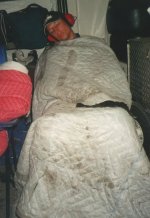 Chris getting some zzzzz's
Chris getting some zzzzz's
The drivers were complaining about vision problems. I saw the windshield during pit stops, and the crew would clean it as best as possible, but it was really bad. It was cracked near the bottom, and all pitted. I donít know how the drivers could see anything. The drivers were now really doing a great job. They were staying out of trouble, and saving the car. I could hear Sid talking to them, reminding them to use the brakes and tires, and to save the engine and transmission. Lots of other 911ís were broken, our car was running like the energizer bunny. Other cars spun, went off course, or hit the wall. The drivers in the #66 car didnít, they just kept on turning good, smooth laps.
3:15 AM, cold and dark. What am I doing here? I could be home, sleeping in my own bed. Instead Iím wearing a purple suit and gloves, Iím all covered in dirt and grime, watching cars go around a track. I must be crazy. Pit stop time, crew ready. Car in, work on it, car back out. Everyone is proud, the car is now in the top 20, 10th in class. Weíre still on the way up. The #67 car is 27th, 14th in class (after replacing THREE water pumps), and the #68 is 28th and 15th after assorted minor problems.
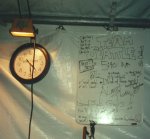 what the pits look like at 4:30 - that's AM.
what the pits look like at 4:30 - that's AM.
About 5:00 AM. I hear a strange noise in the pits. I see the #68 car in, and it sounds like an air compressor. Not good. The engine is down a cylinder. They push the car behind the pits and the crew checks it. They pronounce it dead. How depressing to make it almost through the night, and the car finally dies. They push the car back to the garage, and slowly clean out the pit space. I feel bad for those guys, that was an older car, and it was working great.
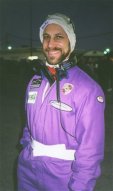 Me, in the pits during the evening.
Me, in the pits during the evening.
5:30 AM (or so), pit stop time again. Richie checked front brake pads last stop, they were OK, but heís going to check them again. He decides to change them. Right side done. The crew is getting tools and tossing them to him. Itís very, very hard to hear anything, but you do the best you can. Iím wearing ear plugs and headphones, and itís still very loud (especially when a corvette or a Ferrari goes by). Richie is working on the left wheel. Caliper open, old pads out, spread pistons, Sid tells the driver not to touch the brake pedal. New pads in, caliper closed, wheel back on, car done. Air jacks down, car back out on track. Kevin is now in the pits. There is some confusion on what brakes are in the car. Did we put rear pads in the front caliper? I donít think so. Don Kitch is driving. He does less than a lap when he reports that something is wrong with the car. Thereís a bad vibration. Crew listens on the radio. Sid and Richie (and Kevin) try to diagnose the problem. Kitch says that he canít drive anymore, the vibration is too bad. He stops somewhere near the bus stop chicane. What to do? Crew goes nuts. Put all sorts of stuff in a golf cart. Weíll go get car and assist. Kevin suggests driving the car slowly around the track and back into the pit. Don tries, then says he canít, heíll really hurt the car. Sid goes out with some crewman. Mass confusion. I listen and try to figure out what is going on. As best as I can tell, Kitch is stuck, and the left front wheel is gone. The crew finds him, we need to bring a jack or nitrogen bottle, wheel nut, and a new wheel. OK, they find the car, the left front sprindle is mangled, the car is on the ground, and wheel is broken. Sid screams on the radio to get a new spindle from the Porsche Motorsports trailer. Kevin will do that. The crew starts assembling tools. Sid and the guys hammer a new wheel onto the bad spindle. The car comes in behind the pit, on the small road. Up on the stands. We have to remove the wheel, remove the spindle, install a new one, install the wheel, then get the car back on the track. There is still some confusion over brake pads, but we donít worry about that now. The clock is running, and we are losing time. Get everything done, send Kitch back on the track. Back into the pits. Kitch reports that he has no brakes, they feel terrible. Sid tells him that the brakes will take some time to come in, the rotor was gouged a little, but once the pads wear in, the brakes will be OK. He tells him to give it 5 laps. Kevin gets on the radio and tells Don that if the brakes arenít better in two laps, to park the car, itís not worth it. The crew is on pins and needles. Weíve come so far, now this. Kitch is on the radio, the brakes are coming back. Weíre back in the race!
Sid gathers the crew together. We listen on the radio as Don Kitch calls in a report on the car. It feels fine Ė handling is good, brakes are good, temps are good. Heís back up to speed. What a relief! We get close to Sid so we can hear him. He tells us that weíre a team. The team screwed up, not any one person. The car is OK, the driver is OK, weíre back in the race. Forget about the problems, they only cost us about 50 minutes. From now till the end of the race, make each stop perfect. I am very impressed with Sid. He has done a tremendous job of handling the car, the drivers, and the crew. He is keeping the drivers calm, focused, and at the right pace. The crew is tired, but loose and happy. The car is working great (once we got 4 wheels on it).
Dawn at Daytona. Weíve dropped back to 24th overall, and 11th in class. So our mishap cost us only one class position. If we can keep the pace up, weíll get that back. Once the sun came up it got a little warmer. I started feeling pretty bad. My head hurt, my stomach hurt, my entire body was aching. I realized that I hadnít been drinking anything. I forced myself to drink some water, went the bathroom, and started feeling better.
10:00 AM, do another pit stop. Sid has it set so we stopped at 10:00, then we only need to do one more stop at 11:30, then we can run until the end. Iíve now been up for 30 hours. I feel fine, but I know that Iím not all there. When I walk I find myself stumbling for no reason. Be sure to go slow, and concentrate. I donít know how the tire guys are still going. They have to do a lot more work than I do. The 66 and 67 crews are now working as a team. When one car stops, the other crew helps, and vice versa. When they stop, I help by taking tires over the wall and stacking them. The person that has probably had the most difficult job is the tire guy. After each stop, he has to make sure the new wheels and tires are ready, then he has to load the old wheels on a cart, take them to Pirelli, and get new wheels mounted. Then he has to make sure the wheel weights are taped, valve stem caps on, and center plates (whatever they are called) are mounted. That is a lot of work to do.
 Sid, the crew chief par excellance!
Sid, the crew chief par excellance!
11:30. The pit is now crowded. The drivers are all there, with wives. Friends are there. The #68 crew comes back. We do our last pit stop. We stay ready in case there is a problem. Two more cars have dropped out, the #2 and the #23. We will catch the 2 car, I donít think weíll catch the #23. The race leading Dyson car is now going very slow. Theyíve lost a cylinder or something. No way is that car going to win. The Viper that was next to us in the garage passes him and will win overall.
1:00 PM. The race is over! The #66 car finished 6th in class, 17th overall. The #67 did a little better, 15th over all, 4th on class. And that was with 3 long stops for water pumps. When the cars come onto pit road, everyone in the pit spills onto the road. Weíve done it, weíve finished the race. It is a very emotional moment, I feel like I have gone through a war. Tears from many people, the drivers, wives, some crew (me included). Big celebration, we have raised over $200,000 for charity. Some pictures of the cars on pit road.
Time to come back to earth. I have a plane to catch. Do some clean up, then we have to leave. Say goodbye to everyone, How can you really say goodbye when you have lived with someone for the past 5 days and been through so much together? Back to the hotel, shower, fall asleep for 30 minutes. I can barely walk. Gather up Henry, Chris and Richie, and we head for the airport. Weíre all beat, but it was a great experience.
Would I do it again? Ask me in 9 months!